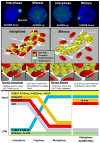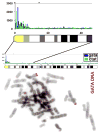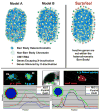XIST RNA and architecture of the inactive X chromosome: implications for the repeat genome
- PMID: 21447818
- PMCID: PMC3143471
- DOI: 10.1101/sqb.2010.75.030
XIST RNA and architecture of the inactive X chromosome: implications for the repeat genome
Abstract
XIST RNA paints and induces silencing of one X chromosome in mammalian female cells, providing a powerful model to investigate long-range chromosomal regulation. This chapter focuses on events downstream from the spread of XIST RNA across the interphase chromosome, to consider how this large noncoding RNA interacts with and silences a whole chromosome. Several lines of evidence are summarized that point to the involvement of repeat sequences in different aspects of the X-inactivation process. Although the "repeat genome" comprises close to half of the human genome, the potential for abundant repeats to contribute to genome regulation has been largely overlooked and may be underestimated. X inactivation has the potential to reveal roles of interspersed and other repeats in the genome. For example, evidence indicates that XIST RNA acts at the architectural level of the whole chromosome to induce formation of a silent core enriched for nongenic and repetitive (Cot-1) DNA, which corresponds to the DAPI-dense Barr body. Expression of repeat RNAs may contribute to chromosome remodeling, and evidence suggests that other types of repeat elements may be involved in escape from X inactivation. Despite great progress in decoding the rest of the genome, we suggest that the repeat genome may contain meaningful but complex language that remains to be better studied and understood.
Figures






Similar articles
-
The X chromosome is organized into a gene-rich outer rim and an internal core containing silenced nongenic sequences.Proc Natl Acad Sci U S A. 2006 May 16;103(20):7688-93. doi: 10.1073/pnas.0601069103. Epub 2006 May 8. Proc Natl Acad Sci U S A. 2006. PMID: 16682630 Free PMC article.
-
Active chromatin marks are retained on X chromosomes lacking gene or repeat silencing despite XIST/Xist expression in somatic cell hybrids.PLoS One. 2010 May 24;5(5):e10787. doi: 10.1371/journal.pone.0010787. PLoS One. 2010. PMID: 20520737 Free PMC article.
-
XIST RNA: a window into the broader role of RNA in nuclear chromosome architecture.Philos Trans R Soc Lond B Biol Sci. 2017 Nov 5;372(1733):20160360. doi: 10.1098/rstb.2016.0360. Philos Trans R Soc Lond B Biol Sci. 2017. PMID: 28947659 Free PMC article. Review.
-
A proximal conserved repeat in the Xist gene is essential as a genomic element for X-inactivation in mouse.Development. 2009 Jan;136(1):139-46. doi: 10.1242/dev.026427. Epub 2008 Nov 26. Development. 2009. PMID: 19036803
-
3D genomic regulation of lncRNA and Xist in X chromosome.Semin Cell Dev Biol. 2019 Jun;90:174-180. doi: 10.1016/j.semcdb.2018.07.013. Epub 2018 Jul 14. Semin Cell Dev Biol. 2019. PMID: 30017906 Review.
Cited by
-
Epigenetic aberrations in human pluripotent stem cells.EMBO J. 2019 Jun 17;38(12):e101033. doi: 10.15252/embj.2018101033. Epub 2019 May 14. EMBO J. 2019. PMID: 31088843 Free PMC article. Review.
-
Shining the Light on Senescence Associated LncRNAs.Aging Dis. 2017 Apr 1;8(2):149-161. doi: 10.14336/AD.2016.0810. eCollection 2017 Apr. Aging Dis. 2017. PMID: 28400982 Free PMC article. Review.
-
Stable C0T-1 repeat RNA is abundant and is associated with euchromatic interphase chromosomes.Cell. 2014 Feb 27;156(5):907-19. doi: 10.1016/j.cell.2014.01.042. Cell. 2014. PMID: 24581492 Free PMC article.
-
Long noncoding RNA and its contribution to autism spectrum disorders.CNS Neurosci Ther. 2017 Aug;23(8):645-656. doi: 10.1111/cns.12710. Epub 2017 Jun 20. CNS Neurosci Ther. 2017. PMID: 28635106 Free PMC article. Review.
-
Differences in Alu vs L1-rich chromosome bands underpin architectural reorganization of the inactive-X chromosome and SAHFs.bioRxiv [Preprint]. 2024 Jan 9:2024.01.09.574742. doi: 10.1101/2024.01.09.574742. bioRxiv. 2024. PMID: 38260534 Free PMC article. Preprint.
References
-
- Allen TA, Von Kaenel S, Goodrich JA, Kugel JF. The SINE-encoded mouse B2 RNA represses mRNA transcription in response to heat shock. Nat Struct Mol Biol. 2004;11:816–821. - PubMed
-
- Britten RJ, Kohne DE. Repeated sequences in DNA: Hundreds of thousands of copies of DNA sequences have been incorporated into the genomes of higher organisms. Science. 1968;161:529–540. - PubMed
-
- Brockdorff N, Ashworth A, Kay GF, McCabe VM, Norris DP, Cooper PJ, Swift S, Rastan S. The Product of the Mouse Xist Gene is a 15 kb Inactive X-Specific Transcript Containing No Conserved ORF and Located in the Nucleus. Cell. 1992;71:515–526. - PubMed
Publication types
MeSH terms
Substances
Grants and funding
LinkOut - more resources
Full Text Sources
Miscellaneous
